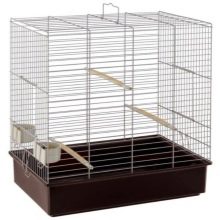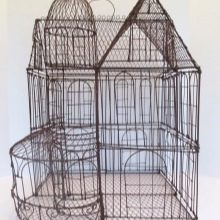At home, the bird is forced to live in a cage. In order for parrots, Amadinas, canaries and other feathered pets to feel comfortable in their home, it is important to take a responsible approach to choosing such a design. Then the bird will quickly get used to it and begin to consider it their home.
Features
In the cage, the bird feels safe. Here she hides from four-legged pets and strangers. In addition, this is a place where she always has food, fresh water is poured, a nest and a swimming pool are arranged. In general, this is a full-fledged birdhouse in which you can sleep comfortably and have fun playing.
The cage is selected according to the size of the bird. Feathered pets can be divided into small (canaries, snails, budgies), medium (corella, pyrrhur) and large (macaw, cockatoos). If there are two individuals, then, respectively, the cell parameters double. In the manufacture of various materials are used: wood, plastic, metal. Some craftsmen design a bird house on their own.



If the owner wants to breed parrots, then not a cage is bought, but a whole aviary, because over time several dozen individuals can live there.
It is advisable to separate a separate room in the house for breeding, and use the old cells, for example, for quarantine.
In addition to conventional standard samples, pet shops can also offer cages, stands, cages on wheels. The standard design provides a place for installing a feeding trough, drinking bowl and bathing bowl, a retractable tray, a door with a strong lock, a roof holder for carrying.



Varieties
Bird cages can be classified by shape.
- Rectangular and square specimens (or domed cells).This is the most preferred option for keeping birds.
- Round or oval cage. In terms of aesthetics, nothing can be compared with this option, however, the pet itself in such a house will be uncomfortable. Many birds like to fall asleep in a corner where they feel safe. In a round cage, the bird will always be tense.
- Complex cell. Such a product may, for example, be semicircular, have protrusions and arches, and a roof of unusual shape. The complex design is not always convenient for the bird, and in some cases it scares it. In addition, it is more difficult to clean and clean such a cage.
Cages for keeping birds at home differ in size, but here, as already mentioned, it is important to build on the variety and breed of the feathered pet. It’s not worthwhile to buy too spacious a product for a small bird with a good cause - in it the pet will not feel comfortable. In too small a space, the bird will become nervous and lethargic.



Choose the parameters according to the dimensions of the animal. For example, for a budgerigar, the recommended cage height is 35–40 cm, width is 25–35 cm, length is 60–80 cm, and a vertical cage 60x50x50 cm in size is more suitable for a corolla.
Design and appearance may also vary. It can be a simple product convenient for a bird, made in a saturated bright solid black or delicate white color, or it can be a real work of art that can be placed in the most prominent place in the house. Songbirds will look especially beautiful in it.
For instance, fashionable now are vintage cages or forged models with a partition. Such an unusual design not only performs practical functions, but also becomes a romantic, touching and special decor element. These cells can fit into the interior of Provence, country, modern or vintage styles.



But do not forget that the main goal of the cage is the comfort and safety of poultry.
Another criterion for the difference is the materials of manufacture.
- Stainless steel. The rods of the product are made from this raw material. This is the most preferred option, as the material is non-toxic, does not oxidize and does not rust.
- Zinc and copper. Rods made of these materials can cause poisoning.
- Wood. This option is suitable as temporary housing. Box-type wooden products can also be used to transport poultry in case of moving or going to the veterinarian. Such an object cannot become a permanent home, since birds easily gnaw through a tree. In addition, this material absorbs moisture, becoming a favorable environment for the growth of bacteria.
- Plastic. This is a non-toxic structure, comfortable and safe, but the material is afraid of high temperatures, so it can not be washed with hot water. Pallets are most often made of plastic.




How to choose?
Going to the store for the feathered pet’s cage, read the recommendations of specialists.
- Buy a cage that is equipped with all the necessary attributes in advance. There is no guarantee that separately purchased feeders, drinking bowls and toys are suitable for a newly acquired facility.
- As already mentioned, it is better to buy a copy of stainless steel. It should not be painted, but may be coated with chrome or a layer of nickel.
- The size of the cage should be such that the bird spread its wings without any problems and waved them without touching the walls.
- Make sure that the lock on the door is secure. The bird should not gnaw at it or learn to open it. Strong doors are considered to be powerful springs that cannot be pressed. Small locks with a key or metal carabiners are also suitable.
- It is best to buy a standard cage, which can be placed on a hill, for example on a cabinet. Watching the situation from above, the bird feels more secure.There are special floor cage stands; in this case, the bird will be on the same level with the person and will not feel comfortable, in addition, the design takes up a lot of space in the apartment, so it is better to refuse this option.


Brands
Most often, bird owners choose cages from domestic Triol. In general, these are good products at a budget price. Also lovers of parrots and canaries are valued Italian manufacturers IMAC and Ferplast, Polish Inter Zoo and German Trixie. All these companies are guided by the safety and convenience of the house for poultry, but even in their assortment there are not the most suitable options, so use the above tips for choosing a cage when buying.



For an overview of a wooden bird cage, see below.










